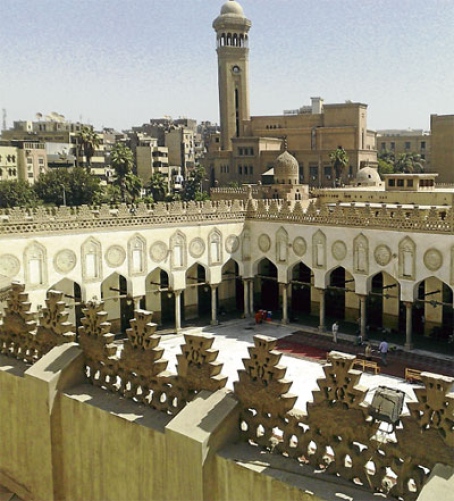More than an endowment
Professor Tan Sri Dato' Dzulkifli Abdul Razak
Learning Curve: Perspective
New Sunday Times - 09-12-2012
THE Malay term waqf or wakaf means a voluntary and irrevocable allocation of a portion of one's wealth in cash or kind.

Universiti of Al-Azhar, Cairo, Egypt was initially financed by its waqf
The word was given a new interpretation at the recent 8th World Islamic Economic Forum, themed Harnessing The Waqf Fund For The Muslim Ummah, in Johor Baru. It was indeed an eye-opener for many.
Awqaf (plural of waqf) are given in perpetuity unlike a foundation or endowment.
The benefactor loses ownership of the part of his wealth that becomes waqf.
A concept in its own right, it has its own "personality". For one, a waqf is used for any syariah-compliant purpose "for the benefit of humankind".
It encompasses a socio-economic and cultural aspect leading to a better quality of life for an individual and the larger community.
Unfortunately, the current scope of waqf has been marginalised and left dormant in many cases.
Even the act of giving has been narrowed down to a category that is broadly regarded as "religious" waqf such as building a mosque.
Indeed, the Quba' mosque in Madinah built upon the arrival of the Prophet Muhammad in 622 is one example.
It is still standing on the same property and has been redeveloped through the years. Other forms of "religious" waqf include real estate to provide revenue for the maintenance of mosques and other religious institutions.
The "philanthropic" dimension of waqf is often left out unlike the days of the Ottomans, for instance, which go beyond real estate investment alone.
It included resources such as cash and jewellery as well as precious metals which were loaned to people, with some "returns" to enhance the economic standing of waqf.
This has expanded to aspects of education, healthcare and research and development which are more intangible in nature.
In the case of Malaysia, Tabung Haji is the oft-repeated example that has brought much benefit though it is still primarily meant to fullfil the "religious" obligation to perform the haj.
According to Imam Abu Hanifa, the legal meaning of "philanthropic" waqf is "in charity of the poor or other good objects".
This includes libraries, educational institutions, healthcare facilities, orphanages and other public infrastructure including parks, roads, bridges and dams.
The first of such waqf began when a man called Mukhairiq bequeathed his seven orchards in Madinah to Prophet Muhammad. Upon Mukhairiq's death, Prophet Muhammad turned the orchards into a "philanthropic" waqf for the benefit of the poor.
Interestingly, from the early days of Islam, education has been financed through waqf, apart from infaq (charity simply to please God without asking for anything in return) and sadaqah (voluntary alms).
Certain properties have been assigned as waqf of educational institutions to fund education as the beneficiary of waqf revenues.
This goes back to the times of awqaf of the Ayubites (1171-1249) and Mamalik (1249-1517) in Palestine and Egypt. The University of Al-Azhar founded in Cairo, Egypt in 972 was initially financed by its waqf.
So too the first university in the world, which according to United Nations Educational, Scientific and Cultural Organisation, is the Al-Qarawiyyin University in Fes, Morocco.
It was endowed by Fatima al Fitr more than a century before University of Al-Azhar.
The Islamic Religious Council of Singapore has launched Ilmu, specifically to finance education. Individuals can donate cash, regardless of the amount.
It is time for the Higher Education Ministry to set up Institut Pengajian Tinggi aimed at enhancing the waqf instrument to close widening gaps in higher education access and success.
- The writer is the vice-chancellor of Albukhary International University
